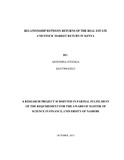| dc.description.abstract | The stock market performance has been known to be a good indicator of the economic
performance of a country. Over time, investors have been making investments in the
stock market, but a lot of attention has shifted to the real estate market as it has been
growing as a result of the huge housing demand. The objective of the study was to look at
the relationship of between real estate and the stock market.
With this objective, we sought to investigate the relationship by comparing the indices for
both the stock and real estate markets. Since the analysis covered the periods between
2008 and 2012, we used the NSE 20 share index for the stock market and Hass property
index for the real estate.
Relevant literature was analyzed with regards to the study, looking at local and
international studies and this enabled the study to come up with a conceptual framework
and an analysis model.
Data was collected from the Nairobi Stock Exchange, Kenya National Bureau of
Statistics (KNBS) and websites such as www.hassconsult.co.ke. The data collected was
then analyzed using regression analysis and Pearson’s correlation coefficient. Control
variables that were introduced in the models were inflation rates and interest rates. These
tests enabled the study to determine the nature and extent of relationship between the two
variables.
The data findings were presented in tables, indicating the mean, standard deviation,
correlation coefficient (r), and the coefficient of determination (R2). The descriptive
information (mean and standard deviation) characterized the data while regression and
correlation tests provided the nature and extent of relationship between the two variables.
The study results showed that there was relationship when there were no control variables
in the model, but there was greater impact and relationship when there were controls
introduced in the models. This was seen from the R values of 0.464 (with no control
variables), 0.785 (with inflation rate control), 0.585 (with interest rate control), and 0.807
(with both interest rate and inflation rate controls).
The study recommended that the country needs a REITs market in order to monitor the
real estate market since it is an important segment of the economy and may act as an
economic barometer, and also to improve the storage of vital macro-economic
information to enable researchers carry out tests that may assist the economy.
A few challenges were encountered during the study and they were mainly in regards to
data collection. Some macro-economic measures were not present limiting our study to
start from 2009 and not 2008 as the study had planned. Also some of the indices, such as
housing index were derived from private institutions of which the study recommended
should be provided by government. | en |

